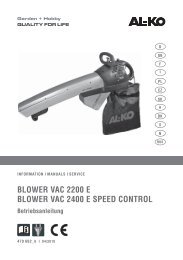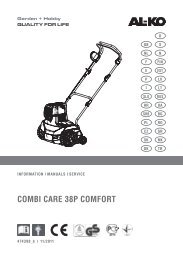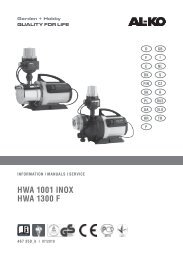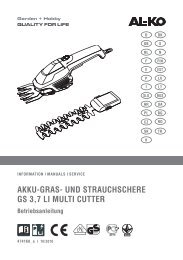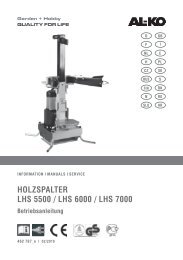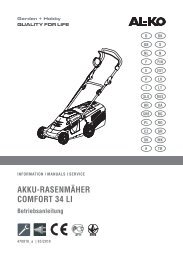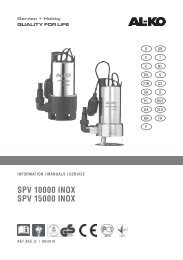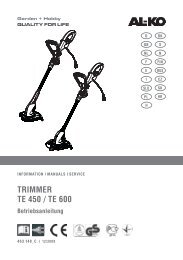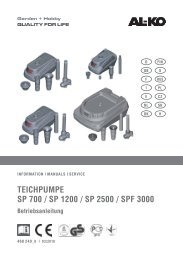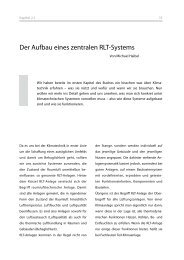TDS 1001/3 TDS 1201/4 - AL-KO
TDS 1001/3 TDS 1201/4 - AL-KO
TDS 1001/3 TDS 1201/4 - AL-KO
Create successful ePaper yourself
Turn your PDF publications into a flip-book with our unique Google optimized e-Paper software.
6. Plug the pump into the socket. As soon as<br />
the pump has reached the cut-in (= START)<br />
level, the float switch will automatically<br />
switch the pump on. When the liquid has<br />
fallen below the cut-off (=STOP) level, the<br />
pump will automatically switch off, see technical<br />
data.<br />
Take suitable measures, e.g. installation<br />
of an alarm or a back-up pump, to ensure<br />
that flooding will not occur if the pump<br />
should malfunction.<br />
Make sure that the pump does not run<br />
with a blocked or closed pressure hose.<br />
Pumping out to the minimum<br />
submersed depth<br />
Adjusting the cut-in and cut-off levels<br />
The float switch cable is attached to the pump<br />
housing. You can adjust the cut-in = START and<br />
cut-off = STOP levels for operation by simply<br />
changing the height of the switch as desired.<br />
Recommended length of the float switch cable is<br />
approx. 120 mm.<br />
Switching off the Pump<br />
1. To switch off the pump, just pull the plug of<br />
the electric cable from the socket.<br />
Maintenance and Cleaning<br />
Before you can pump out to the minimum submersed<br />
depth of 170 mm, you will have to operate<br />
the float switch manually: Cleaning the pump<br />
1. Unplug the electric cable.<br />
2. Fix the float switch so that it remains in an<br />
upright position.<br />
3. Plug in the electric cable. The pump will<br />
automatically switch on and pump out any<br />
remaining liquid.<br />
While pumping to the minimum submersed<br />
depth, make sure to keep the<br />
pump under observation and turn it off by<br />
pulling the plug when the minimum submersed<br />
depth has been reached to prevent<br />
the pump from sucking in air, as this<br />
may damage your pump.<br />
If the level of the remaining water drops<br />
below the minimum submersed depth, the<br />
pump will suck in air. Before using the<br />
pump again to drain liquid, the air trapped<br />
in the pump will have to be vented (see<br />
Setting up and Operating the Pump).<br />
Before beginning any maintenance or<br />
cleaning work, make sure that the pump<br />
has been unplugged and take precautions<br />
to ensure that it cannot be switched on<br />
during work!<br />
− If you have used your pump to pump chlorine<br />
water (pool water) or liquids which leave a<br />
residue, flush your pump out with clear water<br />
after use.<br />
− Clean the inlet strainer located in the suction<br />
body with clear water as required.<br />
Protect from frost<br />
Your pump is susceptible to low temperatures.<br />
Make sure to empty the pump of<br />
residual liquid and store it so that it is<br />
protected from frost.<br />
Disposal<br />
Do not dispose of the pump with<br />
the household garbage; the pump<br />
must be disposed of properly.<br />
The packaging and accessories<br />
are all produced from recyclable<br />
materials and must be disposed<br />
of accordingly.<br />
GB 3 Translation of original user instructions



